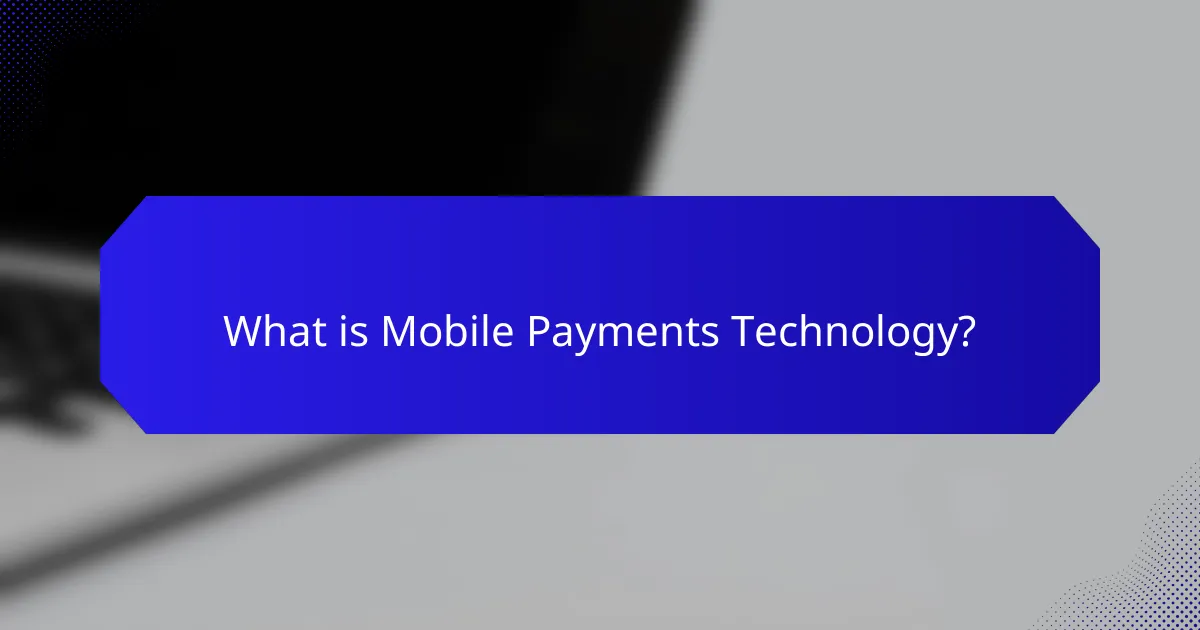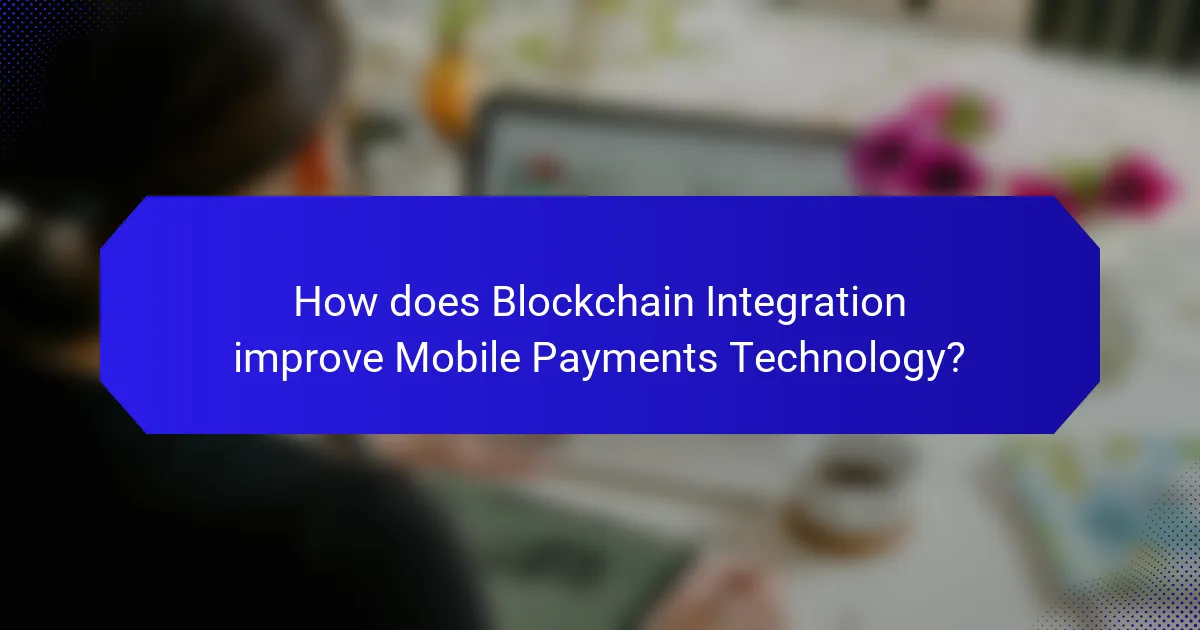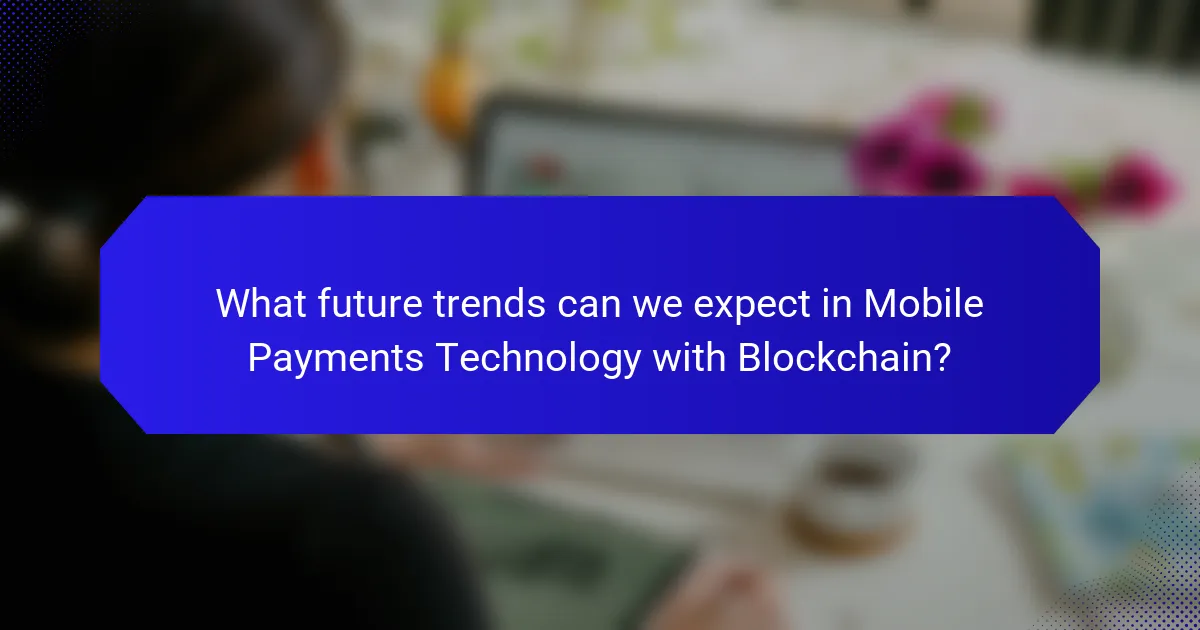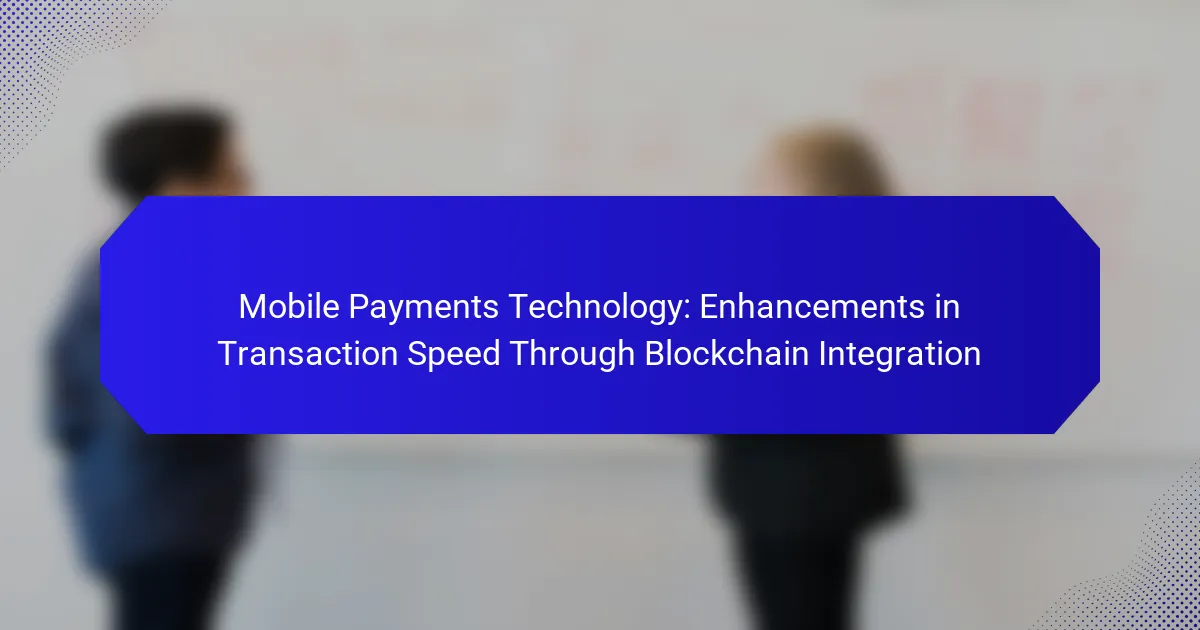Mobile payments technology encompasses systems and processes that facilitate financial transactions through mobile devices, utilizing methods such as near-field communication (NFC), QR codes, and online payment gateways. This technology significantly enhances transaction speed and convenience, contributing to a projected global market growth to over $12 trillion by 2025. The integration of blockchain technology further improves mobile payments by enabling real-time processing, reducing costs, and enhancing security through decentralized transaction recording. Future trends indicate increased transaction speeds, greater security measures, and the wider adoption of cryptocurrencies, signaling a transformative shift in global payment processing.

What is Mobile Payments Technology?
Mobile payments technology refers to the systems and processes that allow users to make financial transactions using their mobile devices. This technology enables users to pay for goods and services via apps or mobile wallets. It typically involves the use of near-field communication (NFC), QR codes, or online payment gateways. Mobile payments can enhance transaction speed and convenience. According to a report by Statista, the global mobile payment market is expected to reach over $12 trillion by 2025. This growth indicates a significant shift towards digital transactions in various sectors.
How does Mobile Payments Technology function?
Mobile payments technology functions by enabling users to make transactions using their mobile devices. This process typically involves the use of Near Field Communication (NFC), QR codes, or mobile apps linked to bank accounts. Users initiate a payment by selecting a payment method on their device. The device then communicates with a payment terminal or server to process the transaction. This communication can occur through various technologies, including NFC or the internet. Once the transaction is authorized, the funds are transferred from the user’s account to the merchant’s account. According to a report by Statista, mobile payment transaction volume worldwide is expected to reach $12 trillion by 2025, indicating the growing adoption of this technology.
What are the key components of Mobile Payments Technology?
Key components of mobile payments technology include mobile wallets, payment gateways, and security protocols. Mobile wallets store users’ payment information securely. Payment gateways facilitate transactions between consumers and merchants. Security protocols ensure data protection during transactions. NFC (Near Field Communication) technology allows contactless payments. QR codes provide a method for scanning and processing payments. Blockchain technology enhances transaction speed and security. These components work together to enable efficient and secure mobile transactions.
How do these components interact to facilitate transactions?
Mobile payments technology and blockchain components interact to facilitate transactions by enabling secure, fast, and transparent exchanges. The mobile payment system acts as the user interface for initiating transactions. Blockchain serves as a decentralized ledger, ensuring that all transaction records are immutable and verifiable.
When a user initiates a payment, the mobile app encrypts the transaction details. This information is then sent to the blockchain network. The blockchain processes the transaction through consensus mechanisms, confirming its validity. Once validated, the transaction is recorded on the blockchain, providing a permanent record.
This interaction reduces transaction times significantly compared to traditional banking methods. According to a study by the World Economic Forum, blockchain can decrease transaction settlement times from days to seconds. This efficiency enhances user experience and trust in mobile payment systems.
What are the advantages of using Mobile Payments Technology?
Mobile payments technology offers convenience, speed, and security. Users can complete transactions quickly using their smartphones. This reduces the time spent at checkout. According to a study by Statista, mobile payment transaction value is expected to reach $12 trillion by 2024. This growth indicates widespread adoption and trust in the technology. Additionally, mobile payments often incorporate advanced security features such as encryption and biometric authentication. These features help protect user data and reduce fraud. Furthermore, mobile payments can facilitate contactless transactions, which have become increasingly important in a post-pandemic world. Overall, mobile payments streamline the purchasing process while enhancing user security.
How does Mobile Payments Technology enhance user convenience?
Mobile payments technology enhances user convenience by allowing quick and easy transactions via smartphones. Users can make payments without needing cash or cards. This technology supports contactless payments, reducing transaction time. Mobile wallets store multiple payment methods securely. Users can access their payment information instantly. The integration of biometric authentication increases security and simplifies the payment process. Studies show that mobile payments can reduce checkout times by up to 50%. Overall, these features streamline the purchasing experience for users.
What security measures are in place within Mobile Payments Technology?
Mobile payments technology employs several security measures to protect transactions. Encryption is a primary method, ensuring that sensitive data is scrambled during transmission. Tokenization replaces sensitive card information with unique identifiers, minimizing exposure to fraud. Multi-factor authentication adds an extra layer of security by requiring additional verification steps from users. Secure Socket Layer (SSL) certificates are utilized to establish encrypted links between servers and clients. Biometric authentication, such as fingerprint or [censured] recognition, enhances user verification. Regular security updates and compliance with standards like PCI DSS further safeguard mobile payment systems. According to a report by the Federal Reserve, these measures significantly reduce the risk of data breaches in mobile transactions.

How does Blockchain Integration improve Mobile Payments Technology?
Blockchain integration improves mobile payments technology by enhancing transaction speed and security. It enables real-time processing of payments, reducing the time taken for transactions to settle. Traditional payment systems often involve intermediaries that slow down transaction times. Blockchain eliminates these intermediaries, allowing for peer-to-peer transactions.
Additionally, blockchain’s decentralized nature increases security by making transactions more resistant to fraud. Each transaction is recorded on a public ledger, ensuring transparency and traceability. According to a study by the World Economic Forum, blockchain could reduce payment processing costs by up to 50%. This efficiency leads to lower transaction fees for users. Overall, blockchain integration streamlines mobile payments, making them faster and safer.
What role does blockchain play in transaction speed?
Blockchain enhances transaction speed by enabling decentralized and direct peer-to-peer transactions. This eliminates intermediaries, which typically slow down traditional payment processes. Transactions on a blockchain can be confirmed in minutes or seconds, depending on the network. For example, Bitcoin transactions can take about 10 minutes, while newer blockchains like Solana can confirm transactions in under one second. The use of smart contracts further automates processes, reducing the time needed for manual verification. Additionally, blockchain’s distributed ledger technology ensures that all parties have real-time access to transaction data. This transparency can speed up dispute resolution and reconciliation. Overall, blockchain significantly improves the efficiency and speed of mobile payment transactions.
How does blockchain technology reduce transaction times?
Blockchain technology reduces transaction times by eliminating intermediaries in payment processing. Traditional systems often require multiple parties to verify transactions, which can be time-consuming. Blockchain enables direct peer-to-peer transactions, streamlining the process. This technology uses a decentralized ledger to record transactions in real-time. Each transaction is verified by network participants through consensus mechanisms. This reduces the need for third-party approvals and speeds up finalization. Studies show that blockchain can process transactions in seconds compared to traditional banking systems that may take days. For instance, Ripple’s blockchain can settle transactions in approximately 4 seconds.
What are the implications of faster transactions for businesses?
Faster transactions significantly enhance business efficiency and customer satisfaction. They reduce the time required for payment processing, allowing businesses to serve customers more quickly. This can lead to increased sales as customers are less likely to abandon purchases due to long wait times. Faster transactions also improve cash flow management by enabling quicker access to funds. According to a study by the Federal Reserve, businesses that adopt faster payment technologies see a 20% increase in transaction volume. Additionally, faster transactions can enhance competitiveness by allowing businesses to respond rapidly to market changes. Overall, faster transaction speeds positively impact operational efficiency and customer loyalty.
What challenges does Blockchain Integration present in Mobile Payments?
Blockchain integration presents several challenges in mobile payments. One significant challenge is scalability. Blockchain networks often struggle to handle a high volume of transactions simultaneously. For example, Bitcoin processes about 7 transactions per second, while Visa can handle over 24,000.
Another challenge is regulatory compliance. Different jurisdictions have varying regulations concerning cryptocurrency and blockchain use. This inconsistency can complicate the implementation of mobile payment solutions.
Security is also a concern. While blockchain is generally secure, vulnerabilities can still exist, especially in mobile applications. Reports indicate that mobile wallets have been targeted by hackers, leading to significant financial losses.
User experience can be negatively impacted as well. The complexity of using blockchain technology may deter non-technical users. A study by the Cambridge Centre for Alternative Finance found that many potential users find blockchain applications difficult to navigate.
Lastly, integration with existing payment systems poses a challenge. Many businesses rely on traditional payment infrastructures. Transitioning to blockchain requires significant investment and technical expertise. This can slow down adoption rates.
How do scalability issues affect transaction speed?
Scalability issues directly reduce transaction speed in blockchain systems. When a blockchain network cannot handle a high volume of transactions, delays occur. Each transaction requires processing by multiple nodes. Limited capacity leads to longer wait times for transaction confirmations. For instance, Bitcoin can process about 7 transactions per second. In contrast, traditional payment systems can handle thousands of transactions per second. As demand increases, the network becomes congested. This congestion results in slower transaction times and higher fees. Thus, scalability challenges significantly hinder the efficiency of mobile payment technologies utilizing blockchain.
What regulatory concerns arise with blockchain in mobile payments?
Regulatory concerns with blockchain in mobile payments include compliance with financial regulations. Blockchain technology can complicate adherence to anti-money laundering (AML) and know your customer (KYC) requirements. The decentralized nature of blockchain may hinder the ability to trace transactions effectively. This raises concerns about fraud and illicit activities. Additionally, jurisdictions may have differing regulations affecting blockchain usage. The lack of a central authority can create challenges in enforcing regulations. There are also concerns regarding consumer protection and data privacy. These issues necessitate a clearer regulatory framework to ensure safety and compliance in mobile payments.

What future trends can we expect in Mobile Payments Technology with Blockchain?
Future trends in mobile payments technology with blockchain include increased transaction speeds, enhanced security, and wider adoption of cryptocurrencies. Blockchain technology enables faster processing times by eliminating intermediaries. Transactions can be completed in seconds rather than days. Enhanced security features, such as cryptographic encryption, reduce fraud risks. This technology also facilitates cross-border payments with lower fees. According to a report by Deloitte, blockchain can cut transaction costs by up to 40%. Furthermore, the integration of smart contracts automates transactions, increasing efficiency. The growing acceptance of digital wallets indicates a shift towards mobile-first payment solutions. Overall, these trends indicate a significant transformation in how payments are processed globally.
How will advancements in blockchain technology shape mobile payments?
Advancements in blockchain technology will significantly enhance mobile payments. Blockchain enables faster transaction processing by eliminating intermediaries. This technology provides real-time settlement, reducing the time for transactions from days to seconds. Enhanced security features in blockchain protect against fraud and unauthorized access. Smart contracts automate payment processes, increasing efficiency and reducing costs. According to a report by PwC, blockchain can reduce payment processing costs by up to 80%. Moreover, blockchain’s transparency fosters trust among users, encouraging wider adoption of mobile payment solutions. Overall, these advancements will revolutionize the mobile payment landscape.
What innovations are on the horizon for transaction speed?
Innovations on the horizon for transaction speed include the implementation of layer-2 solutions for blockchain technology. These solutions, such as the Lightning Network for Bitcoin, enable faster transactions by processing them off the main blockchain. Another innovation is sharding, which divides the blockchain into smaller, manageable pieces, allowing for parallel processing of transactions. Additionally, advancements in consensus algorithms, like Proof of Stake, can significantly reduce transaction validation times. Research indicates that these methods can enhance transaction speeds to thousands of transactions per second. For instance, Ethereum 2.0 aims to increase throughput to over 100,000 transactions per second with its new architecture. These innovations collectively promise to revolutionize mobile payment systems by making transactions faster and more efficient.
What best practices should users follow when using Mobile Payments Technology?
Users should follow several best practices when using mobile payments technology. First, always use secure connections. Avoid public Wi-Fi for transactions. Second, enable two-factor authentication. This adds an extra layer of security. Third, regularly update payment apps. Updates often include security patches. Fourth, monitor account activity frequently. This helps detect unauthorized transactions early. Fifth, use strong, unique passwords. Avoid using the same password across multiple accounts. Lastly, educate yourself about phishing scams. Be cautious of unsolicited messages asking for payment information. Following these practices can significantly enhance the security of mobile payment transactions.
How can users ensure secure transactions in mobile payments?
Users can ensure secure transactions in mobile payments by utilizing strong authentication methods. Implementing two-factor authentication adds an extra layer of security. Regularly updating mobile payment apps helps protect against vulnerabilities. Users should also avoid public Wi-Fi when making transactions, as it can expose sensitive information. Employing encryption technology secures data during transmission. Monitoring account statements frequently allows users to spot unauthorized transactions quickly. Lastly, using reputable payment platforms reduces the risk of fraud. According to a study by the Federal Trade Commission, 30% of consumers reported unauthorized charges through mobile payments, highlighting the importance of these security measures.
What tips can enhance the efficiency of mobile payment transactions?
Utilizing secure and reliable mobile payment apps enhances transaction efficiency. Choose apps that support quick processing times. Ensure your device’s software is up to date for optimal performance. Use a stable internet connection to prevent delays. Enable biometric authentication for faster access. Store payment information securely for quicker checkouts. Familiarize yourself with the app’s features to maximize usability. Regularly review transaction history to identify and resolve issues promptly.
Mobile payments technology enables users to conduct financial transactions via mobile devices, utilizing systems such as NFC, QR codes, and mobile wallets. The article explores how blockchain integration enhances transaction speed, security, and efficiency in mobile payments, addressing key components like mobile wallets, payment gateways, and security protocols. It also discusses the advantages of mobile payments, including convenience and reduced fraud risks, while highlighting challenges such as scalability and regulatory compliance. Furthermore, future trends indicate a shift towards faster, more secure transactions, driven by advancements in blockchain technology.
